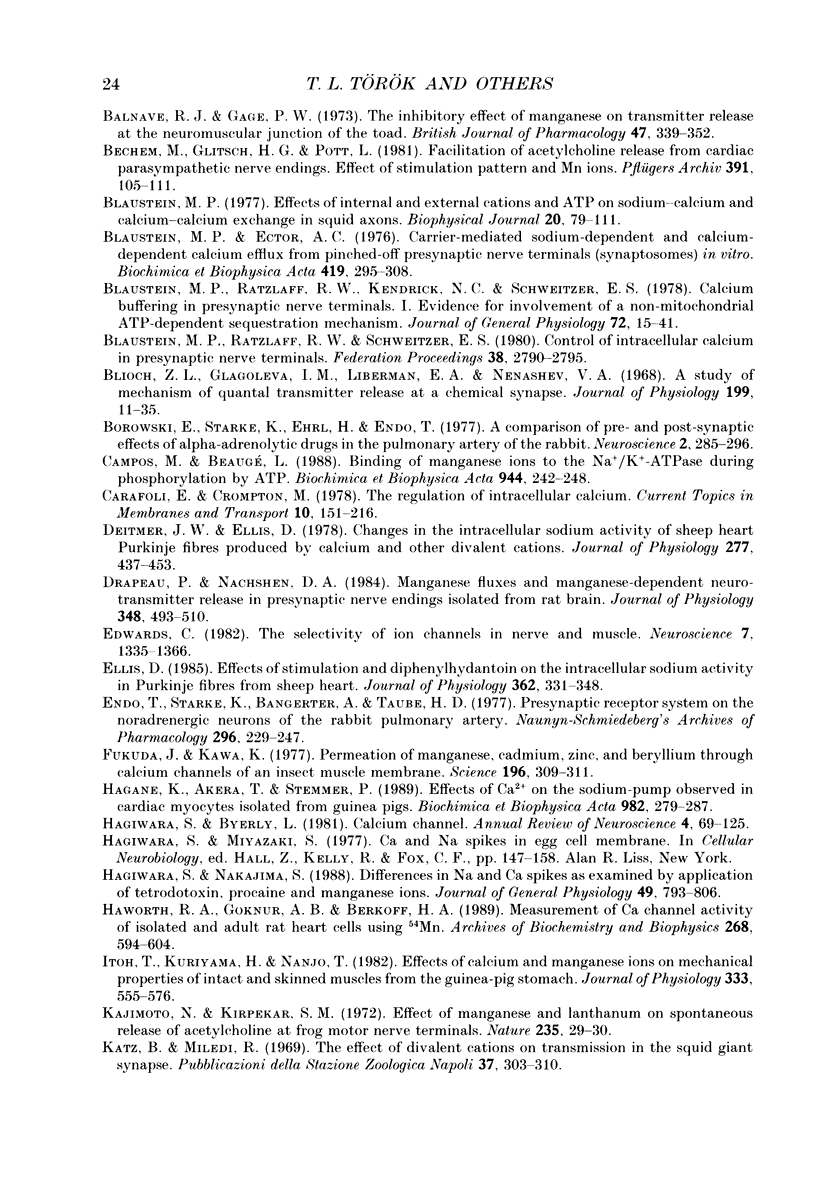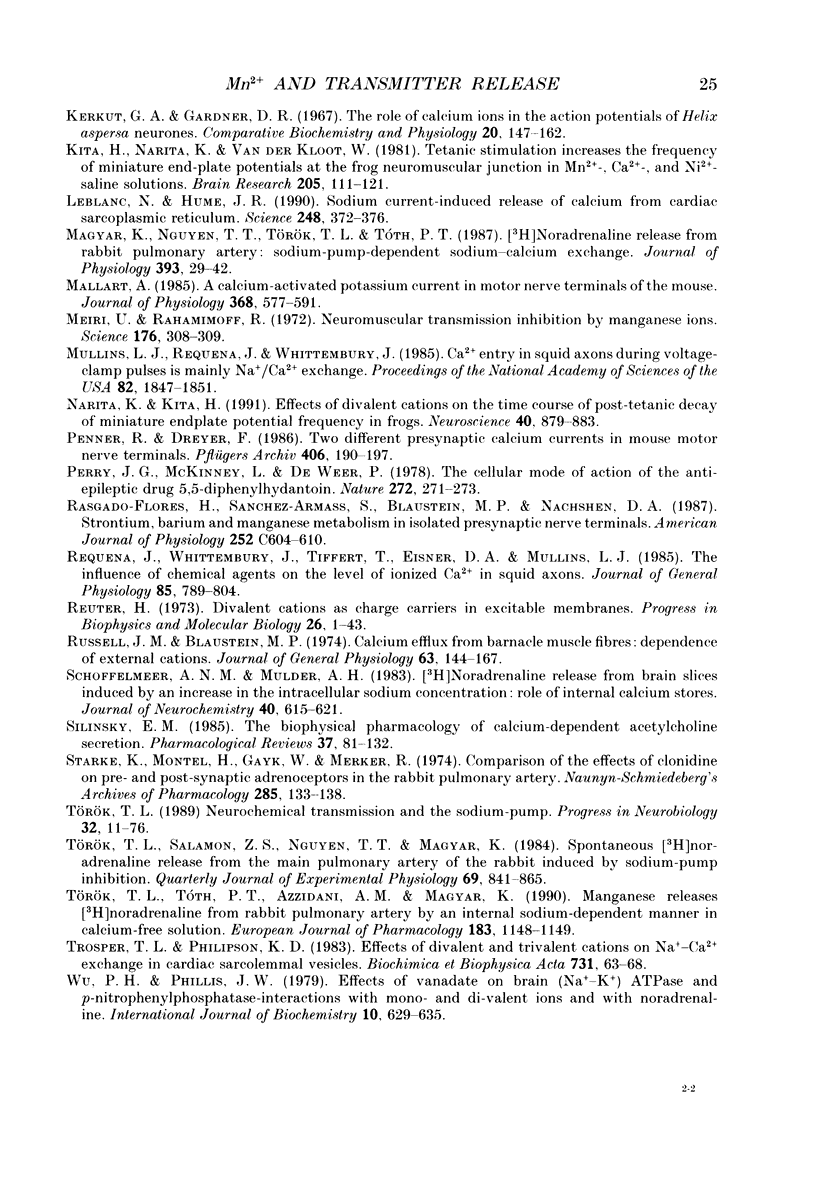Abstract
1. [3H]Noradrenaline ([3H]NA) release from the isolated main pulmonary artery of the rabbit has been measured in the presence of uptake blockers (cocaine, 3 x 10(-5) M, and corticosterone, 5 x 10(-5) M) and after blocking the monoamine oxidase enzyme by pargyline (1.2 x 10(-4) M). 2. In normal Krebs solution Mn2+ (2 mM) significantly inhibited both [3H]NA release (approximately 80%; P < 0.001) and the contraction following 2 Hz field stimulation. 3. In Ca(2+)-free, EGTA (1 mM)-containing solution, the Na+ pump was inhibited by removal of K+ from the external medium. In Na+ pump-inhibited arteries, 2 mM Mn2+ (free Mn2+, 1 mM) increased the spontaneous release of [3H]NA according to the time of Na+ loading. TTX (10(-7) M) did not inhibit significantly the Mn(2+)-induced [3H]NA release from Na(+)-loaded preparations (percentage inhibition, approximately 24; P > 0.30). 4. Without Na+ loading (Ca2+ free, EGTA alone), Mn2+ failed to promote 3H release from arteries. 5. With constant Na+ loading (120 min 'K(+)-free' perfusion in Ca(2+)-free, 1 mM EGTA-containing solution), the release of 3H was also directly dependent on free Mn2+ concentration (0.2, 0.6 and 1 mM). 6. The Mn2+ (2 mM; free Mn2+, 1 mM)-induced 3H release from Na(+)-loaded nerves (120 min 'K(+)-free', perfusion) was further enhanced, when external Na+ was simultaneously reduced from 139.2 to 26.2 mM (choline+ or sucrose substitution). 7. Diphenylhydantoin (DPH, 10(-4) M) significantly reduced the Mn(2+)-evoked 3H release (approximately 44%; P < 0.02) when it was present during 'K(+)-free', perfusion. 8. Mn2+ was ineffective in releasing 3H if the Na+ pump was previously reactivated by readmission of K+ to Na(+)-loaded arteries. 9. It is concluded that in Ca(2+)-free solution Mn2+ releases neurotransmitter in a manner which depends on the degree of loading with internal Na+. The results suggest this depends at least partly on a block of Ca2+ efflux.
Full text
PDF














Selected References
These references are in PubMed. This may not be the complete list of references from this article.
- Aickin C. C., Brading A. F., Walmsley D. An investigation of sodium-calcium exchange in the smooth muscle of guinea-pig ureter. J Physiol. 1987 Oct;391:325–346. doi: 10.1113/jphysiol.1987.sp016741. [DOI] [PMC free article] [PubMed] [Google Scholar]
- Alnaes E., Rahamimoff R. On the role of mitochondria in transmitter release from motor nerve terminals. J Physiol. 1975 Jun;248(2):285–306. doi: 10.1113/jphysiol.1975.sp010974. [DOI] [PMC free article] [PubMed] [Google Scholar]
- Baker P. F., Crawford A. C. A note of the mechanism by which inhibitors of the sodium pump accelerate spontaneous release of transmitter from motor nerve terminals. J Physiol. 1975 May;247(1):209–226. doi: 10.1113/jphysiol.1975.sp010928. [DOI] [PMC free article] [PubMed] [Google Scholar]
- Baker P. F., Hodgkin A. L., Ridgway E. B. Depolarization and calcium entry in squid giant axons. J Physiol. 1971 Nov;218(3):709–755. doi: 10.1113/jphysiol.1971.sp009641. [DOI] [PMC free article] [PubMed] [Google Scholar]
- Baker P. F., Schlaepfer W. W. Uptake and binding of calcium by axoplasm isolated from giant axons of Loligo and Myxicola. J Physiol. 1978 Mar;276:103–125. doi: 10.1113/jphysiol.1978.sp012222. [DOI] [PMC free article] [PubMed] [Google Scholar]
- Baker P. F. The sodium-calcium exchange system. Ciba Found Symp. 1986;122:73–92. doi: 10.1002/9780470513347.ch6. [DOI] [PubMed] [Google Scholar]
- Baker P. F. Transport and metabolism of calcium ions in nerve. Prog Biophys Mol Biol. 1972;24:177–223. doi: 10.1016/0079-6107(72)90007-7. [DOI] [PubMed] [Google Scholar]
- Balnave R. J., Gage P. W. The inhibitory effect of manganese on transmitter release at the neuromuscular junction of the toad. Br J Pharmacol. 1973 Feb;47(2):339–352. doi: 10.1111/j.1476-5381.1973.tb08332.x. [DOI] [PMC free article] [PubMed] [Google Scholar]
- Bechem M., Glitsch H. G., Pott L. Facilitation of acetylcholine release from cardiac parasympathetic nerve endings. Effect of stimulation pattern and Mn ions. Pflugers Arch. 1981 Aug;391(2):105–111. doi: 10.1007/BF00656999. [DOI] [PubMed] [Google Scholar]
- Blaustein M. P., Ector A. C. Carrier-mediated sodium-dependent and calcium-dependent calcium efflux from pinched-off presynaptic nerve terminals (synaptosomes) in vitro. Biochim Biophys Acta. 1976 Jan 21;419(2):295–308. doi: 10.1016/0005-2736(76)90355-2. [DOI] [PubMed] [Google Scholar]
- Blaustein M. P., Ratzlaff R. W., Kendrick N. C., Schweitzer E. S. Calcium buffering in presynaptic nerve terminals. I. Evidence for involvement of a nonmitochondrial ATP-dependent sequestration mechanism. J Gen Physiol. 1978 Jul;72(1):15–41. doi: 10.1085/jgp.72.1.15. [DOI] [PMC free article] [PubMed] [Google Scholar]
- Blaustein M. P., Ratzlaff R. W., Schweitzer E. S. Control of intracellular calcium in presynaptic nerve terminals. Fed Proc. 1980 Aug;39(10):2790–2795. [PubMed] [Google Scholar]
- Blaustein M. P., Santiago E. M. Effects of internal and external cations and of ATP on sodium-calcium and calcium-calcium exchange in squid axons. Biophys J. 1977 Oct;20(1):79–111. doi: 10.1016/S0006-3495(77)85538-0. [DOI] [PMC free article] [PubMed] [Google Scholar]
- Blioch Z. L., Glagoleva I. M., Liberman E. A., Nenashev V. A. A study of the mechanism of quantal transmitter release at a chemical synapse. J Physiol. 1968 Nov;199(1):11–35. doi: 10.1113/jphysiol.1968.sp008637. [DOI] [PMC free article] [PubMed] [Google Scholar]
- Borowski E., Starke K., Ehrl H., Endo T. A comparison of pre- and postsynaptic effects of alpha-adrenolytic drugs in the pulmonary artery of the rabbit. Neuroscience. 1977;2(2):285–296. doi: 10.1016/0306-4522(77)90095-1. [DOI] [PubMed] [Google Scholar]
- Campos M., Beaugé L. Binding of manganese ions to the Na+/K+-ATPase during phosphorylation by ATP. Biochim Biophys Acta. 1988 Oct 6;944(2):242–248. doi: 10.1016/0005-2736(88)90437-3. [DOI] [PubMed] [Google Scholar]
- Deitmer J. W., Ellis D. Changes in the intracellular sodium activity of sheep heart Purkinje fibres produced by calcium and other divalent cations. J Physiol. 1978 Apr;277:437–453. doi: 10.1113/jphysiol.1978.sp012283. [DOI] [PMC free article] [PubMed] [Google Scholar]
- Drapeau P., Nachshen D. A. Manganese fluxes and manganese-dependent neurotransmitter release in presynaptic nerve endings isolated from rat brain. J Physiol. 1984 Mar;348:493–510. doi: 10.1113/jphysiol.1984.sp015121. [DOI] [PMC free article] [PubMed] [Google Scholar]
- Edwards C. The selectivity of ion channels in nerve and muscle. Neuroscience. 1982 Jun;7(6):1335–1366. doi: 10.1016/0306-4522(82)90249-4. [DOI] [PubMed] [Google Scholar]
- Ellis D. Effects of stimulation and diphenylhydantoin on the intracellular sodium activity in Purkinje fibres of sheep heart. J Physiol. 1985 May;362:331–348. doi: 10.1113/jphysiol.1985.sp015681. [DOI] [PMC free article] [PubMed] [Google Scholar]
- Endo T., Starke K., Bangerter A., Taube H. D. Presynaptic receptor systems on the noradrenergic neurones of the rabbit pulmonary artery. Naunyn Schmiedebergs Arch Pharmacol. 1977 Feb;296(3):229–247. doi: 10.1007/BF00498689. [DOI] [PubMed] [Google Scholar]
- Fukuda J., Kawa K. Permeation of manganese, cadmium, zinc, and beryllium through calcium channels of an insect muscle membrane. Science. 1977 Apr 15;196(4287):309–311. doi: 10.1126/science.847472. [DOI] [PubMed] [Google Scholar]
- Hagane K., Akera T., Stemmer P. Effects of Ca2+ on the sodium pump observed in cardiac myocytes isolated from guinea pigs. Biochim Biophys Acta. 1989 Jul 10;982(2):279–287. doi: 10.1016/0005-2736(89)90065-5. [DOI] [PubMed] [Google Scholar]
- Hagiwara S., Byerly L. Calcium channel. Annu Rev Neurosci. 1981;4:69–125. doi: 10.1146/annurev.ne.04.030181.000441. [DOI] [PubMed] [Google Scholar]
- Hagiwara S., Miyazaki S. Ca and Na spikes in egg cell membrane. Prog Clin Biol Res. 1977;15:147–158. [PubMed] [Google Scholar]
- Hagiwara S., Nakajima S. Differences in Na and Ca spikes as examined by application of tetrodotoxin, procaine, and manganese ions. J Gen Physiol. 1966 Mar;49(4):793–806. doi: 10.1085/jgp.49.4.793. [DOI] [PMC free article] [PubMed] [Google Scholar]
- Haworth R. A., Goknur A. B., Berkoff H. A. Measurement of Ca channel activity of isolated adult rat heart cells using 54Mn. Arch Biochem Biophys. 1989 Feb 1;268(2):594–604. doi: 10.1016/0003-9861(89)90327-5. [DOI] [PubMed] [Google Scholar]
- Itoh T., Kuriyama H., Nanjo T. Effects of calcium and manganese ions on mechanical properties of intact and skinned muscles from the guinea-pig stomach. J Physiol. 1982 Dec;333:555–576. doi: 10.1113/jphysiol.1982.sp014469. [DOI] [PMC free article] [PubMed] [Google Scholar]
- Kajimoto N., Kirpekar S. M. Effect of manganese and lanthanum on spontaneous release of acetylcholine at frog motor nerve terminals. Nat New Biol. 1972 Jan 5;235(53):29–30. doi: 10.1038/newbio235029a0. [DOI] [PubMed] [Google Scholar]
- Kita H., Narita K., Van der Kloot W. Tetanic stimulation increases the frequency of miniature end-plate potentials at the frog neuromuscular junction in Mn2+-, CO2+-, and Ni2+-saline solutions. Brain Res. 1981 Jan 26;205(1):111–121. doi: 10.1016/0006-8993(81)90723-x. [DOI] [PubMed] [Google Scholar]
- Leblanc N., Hume J. R. Sodium current-induced release of calcium from cardiac sarcoplasmic reticulum. Science. 1990 Apr 20;248(4953):372–376. doi: 10.1126/science.2158146. [DOI] [PubMed] [Google Scholar]
- Magyar K., Nguyen T. T., Török T. L., Tóth P. T. [3H]noradrenaline release from rabbit pulmonary artery: sodium-pump-dependent sodium-calcium exchange. J Physiol. 1987 Dec;393:29–42. doi: 10.1113/jphysiol.1987.sp016808. [DOI] [PMC free article] [PubMed] [Google Scholar]
- Mallart A. A calcium-activated potassium current in motor nerve terminals of the mouse. J Physiol. 1985 Nov;368:577–591. doi: 10.1113/jphysiol.1985.sp015877. [DOI] [PMC free article] [PubMed] [Google Scholar]
- Meiri U., Rahamimoff R. Neuromuscular transmission: inhibition by manganese ions. Science. 1972 Apr 21;176(4032):308–309. doi: 10.1126/science.176.4032.308. [DOI] [PubMed] [Google Scholar]
- Mullins L. J., Requena J., Whittembury J. Ca2+ entry in squid axons during voltage-clamp pulses is mainly Na+/Ca2+ exchange. Proc Natl Acad Sci U S A. 1985 Mar;82(6):1847–1851. doi: 10.1073/pnas.82.6.1847. [DOI] [PMC free article] [PubMed] [Google Scholar]
- Narita K., Kita H. Effects of divalent cations on the time course of post-tetanic decay of miniature endplate potential frequency in frogs. Neuroscience. 1991;40(3):879–883. doi: 10.1016/0306-4522(91)90019-k. [DOI] [PubMed] [Google Scholar]
- Penner R., Dreyer F. Two different presynaptic calcium currents in mouse motor nerve terminals. Pflugers Arch. 1986 Feb;406(2):190–197. doi: 10.1007/BF00586682. [DOI] [PubMed] [Google Scholar]
- Perry J. G., McKinney L., De Weer P. The cellular mode of action of the anti-epileptic drug 5,5-diphenylhydantoin. Nature. 1978 Mar 16;272(5650):271–273. doi: 10.1038/272271a0. [DOI] [PubMed] [Google Scholar]
- Rasgado-Flores H., Sanchez-Armass S., Blaustein M. P., Nachshen D. A. Strontium, barium, and manganese metabolism in isolated presynaptic nerve terminals. Am J Physiol. 1987 Jun;252(6 Pt 1):C604–C610. doi: 10.1152/ajpcell.1987.252.6.C604. [DOI] [PubMed] [Google Scholar]
- Requena J., Whittembury J., Tiffert T., Eisner D. A., Mullins L. J. The influence of chemical agents on the level of ionized [Ca2+] in squid axons. J Gen Physiol. 1985 Jun;85(6):789–804. doi: 10.1085/jgp.85.6.789. [DOI] [PMC free article] [PubMed] [Google Scholar]
- Reuter H. Divalent cations as charge carriers in excitable membranes. Prog Biophys Mol Biol. 1973;26:1–43. doi: 10.1016/0079-6107(73)90016-3. [DOI] [PubMed] [Google Scholar]
- Russell J. M., Blaustein M. P. Calcium efflux from barnacle muscle fibers. Dependence on external cations. J Gen Physiol. 1974 Feb;63(2):144–167. doi: 10.1085/jgp.63.2.144. [DOI] [PMC free article] [PubMed] [Google Scholar]
- Schoffelmeer A. N., Mulder A. H. [3H]noradrenaline release from brain slices induced by an increase in the intracellular sodium concentration: role of intracellular calcium stores. J Neurochem. 1983 Mar;40(3):615–621. doi: 10.1111/j.1471-4159.1983.tb08025.x. [DOI] [PubMed] [Google Scholar]
- Silinsky E. M. The biophysical pharmacology of calcium-dependent acetylcholine secretion. Pharmacol Rev. 1985 Mar;37(1):81–132. [PubMed] [Google Scholar]
- Starke K., Montel H., Gayk W., Merker R. Comparison of the effects of clonidine on pre- and postsynaptic adrenoceptors in the rabbit pulmonary artery. Alpha-sympathomimetic inhibition of Neurogenic vasoconstriction. Naunyn Schmiedebergs Arch Pharmacol. 1974;285(2):133–150. doi: 10.1007/BF00501149. [DOI] [PubMed] [Google Scholar]
- Trosper T. L., Philipson K. D. Effects of divalent and trivalent cations on Na+-Ca2+ exchange in cardiac sarcolemmal vesicles. Biochim Biophys Acta. 1983 May 26;731(1):63–68. doi: 10.1016/0005-2736(83)90398-x. [DOI] [PubMed] [Google Scholar]
- Török T. L., Salamon Z., Nguyen T. T., Magyar K. Spontaneous [3H]noradrenaline release from the main pulmonary artery of the rabbit induced by sodium-pump inhibition. Q J Exp Physiol. 1984 Oct;69(4):841–865. doi: 10.1113/expphysiol.1984.sp002873. [DOI] [PubMed] [Google Scholar]
- Wu P. H., Phillis J. W. Effects of vanadate on brain (Na + -K+)ATPase and p-nitrophenylphosphate-interaction with mono- and di-valent ions and with noradrenaline. Int J Biochem. 1979;10(7):629–635. doi: 10.1016/0020-711x(79)90026-0. [DOI] [PubMed] [Google Scholar]


